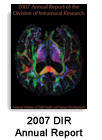Unit on Molecular Neurophysiology and Biophysics
Head: Dax A. Hoffman
With billions of neurons firing at frequencies of hundreds of hertz, the brain exhibits a complexity that is stunning. Our research approach calls for studying the workings of a single central neuron—the pyramidal neuron from the CA1 region of the hippocampus. The hippocampus is a region of the brain important for learning and memory and among the first affected in Alzheimer’s disease and epilepsy. In the dendrites of hippocampal CA1 pyramidal neurons, a nonuniform density of subthreshold, rapidly inactivating potassium channels regulates signal propagation. This nonuniform distribution (with higher expression in the dendrites than in the soma) means that the electrical properties of the dendrites are markedly different from those of the soma. Incoming synaptic signals are shaped by the activity of their channels; once initiated in the axon, action potentials (APs) progressively decrease in amplitude as they propagate back into the dendrites. Combining patch clamp recording with molecular biology, we investigate the electrophysiological properties and molecular nature of the voltage-gated channels expressed in CA1 dendrites, the regulation of their expression, and their role in learning and memory.
Resources
- Employee Listing
- E-Mail the Lab: hoffmand@mail.nih.gov
- UMNB Home Page




